Information - Honu Count Pages
Information - Honu Count Pages.docx
Generic Clearance for Citizen Science and Crowdsourcing Projects
Information - Honu Count Pages
OMB: 0648-0828
Honu Count Project
Help the Pacific Islands Fisheries Science Center’s Marine Turtle Biology and Assessment Program bring a valuable sea turtle data stream to life. Residents and visitors in Hawai'i can help us track sea turtles, or honu, in the main Hawaiian Islands by reporting where they see turtles with white alpha-numeric shell etches.
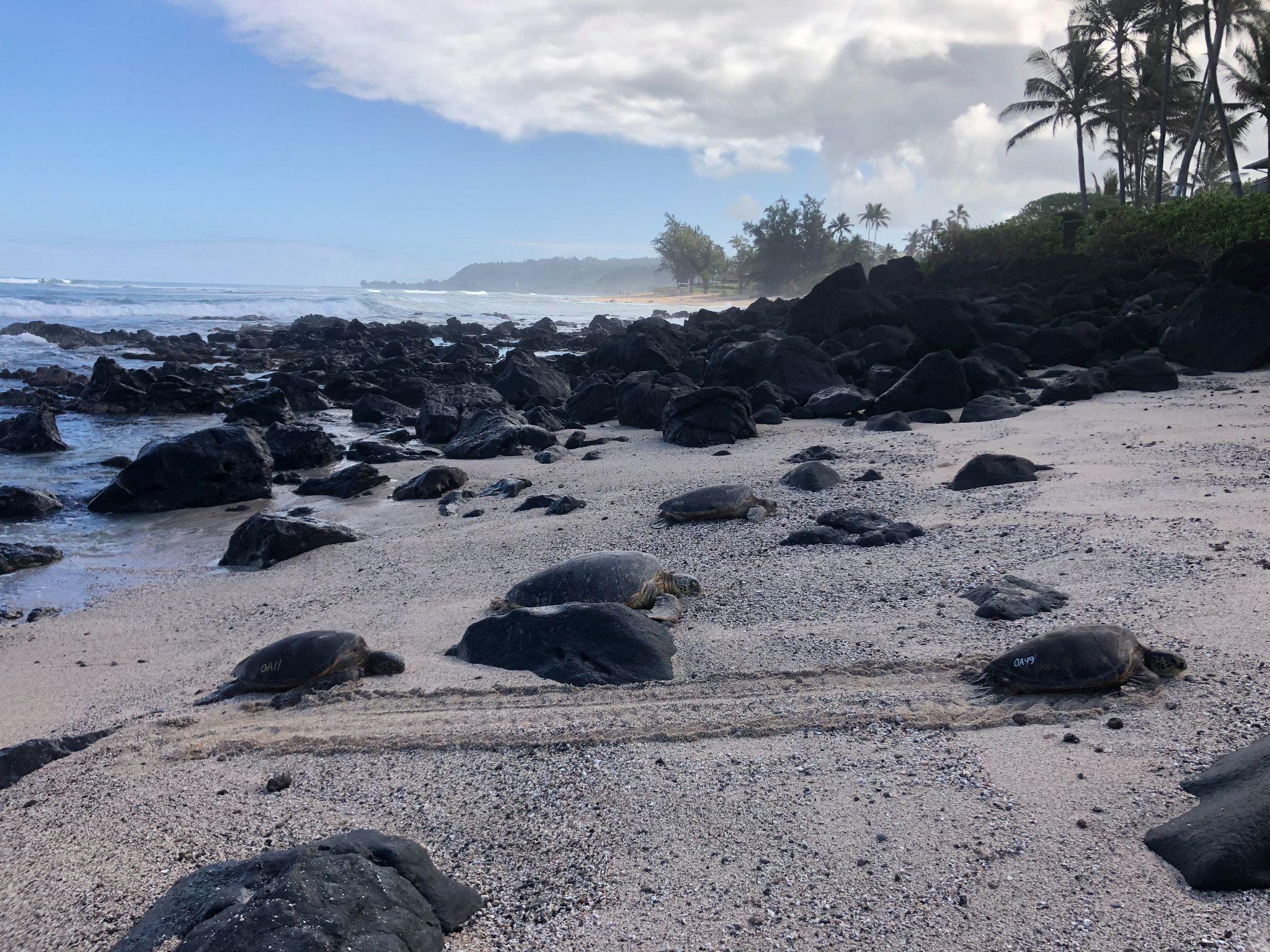
Honu with shell etchings basking at Laniākea Beach on O'ahu’s north shore. Credit: NOAA Fisheries/Camryn Allen

Citizen Science Participation for Honu Count
Background
Imagine swimming 1,200 miles round-trip to bring new life into the world. While an impossible feat for humans, this is exactly what our Hawaiian green sea turtles, or honu, do each year. And when they make this migration, NOAA Fisheries is there to track them—but we could use your help! Reporting sightings of turtles with a white alpha-numeric shell etch helps us understand green sea turtle foraging habitats, migration and distribution, and the survival status of that particular turtle —we're calling it the “Honu Count.”
Most honu that live around the main Hawaiian Islands migrate each spring to reproduce at Lalo, or French Frigate Shoals, in the Papahānaumokuākea Marine National Monument (PMNM), located northwest of the main Hawaiian Islands. This round-trip migration begins at their foraging habitats around the main Hawaiian Islands, and can extend over 1,200 miles. Sea turtles can complete a journey like this because they have an internal compass that uses the earth’s geomagnetic signposts to help navigate them to the beaches where they were born, where they will then mate and lay eggs. More than 96 percent of all honu nest at Lalo, while the rest nest at other areas within the Hawaiian Archipelago.
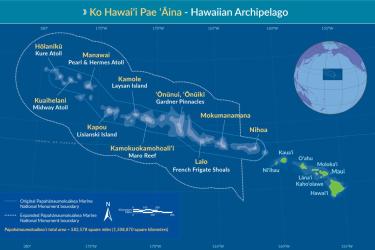
The Hawaiian Archipelago and the range of the Hawaiian green sea turtle, or honu. Within the Papahānaumokuākea Marine National Monument, the common names of the islands are printed in white and the Hawaiian island names are in yellow. Credit: https://www.papahanaumokuakea.gov.
We hope for a great team of citizen scientists to continue to report turtles. Since the inception of Honu Count back in 2018, 612 sightings of almost 200 individual turtles were reported by over 200 members of the public. This valuable scientific information is used to track recently rehabilitated honu, resident turtle habitat use, or nesting turtles from Lalo back to their foraging grounds. NOAA Fisheries will also use the data collected from Honu Count to determine the resilience of the Hawaiian green sea turtle in the face of climate change.
Tips for spotting honu
Look for turtles with a white alpha-numeric etching on the right side of their shell near their hind flippers
Keep a respectful distance of 10 feet on land or in water. Use binoculars or zoom on a camera if you want a closer look.
Take a photo of the etching without disturbing the turtle.
Record the date, time, and location.
Go to the Honu Count Sighting Survey to submit your sighting.
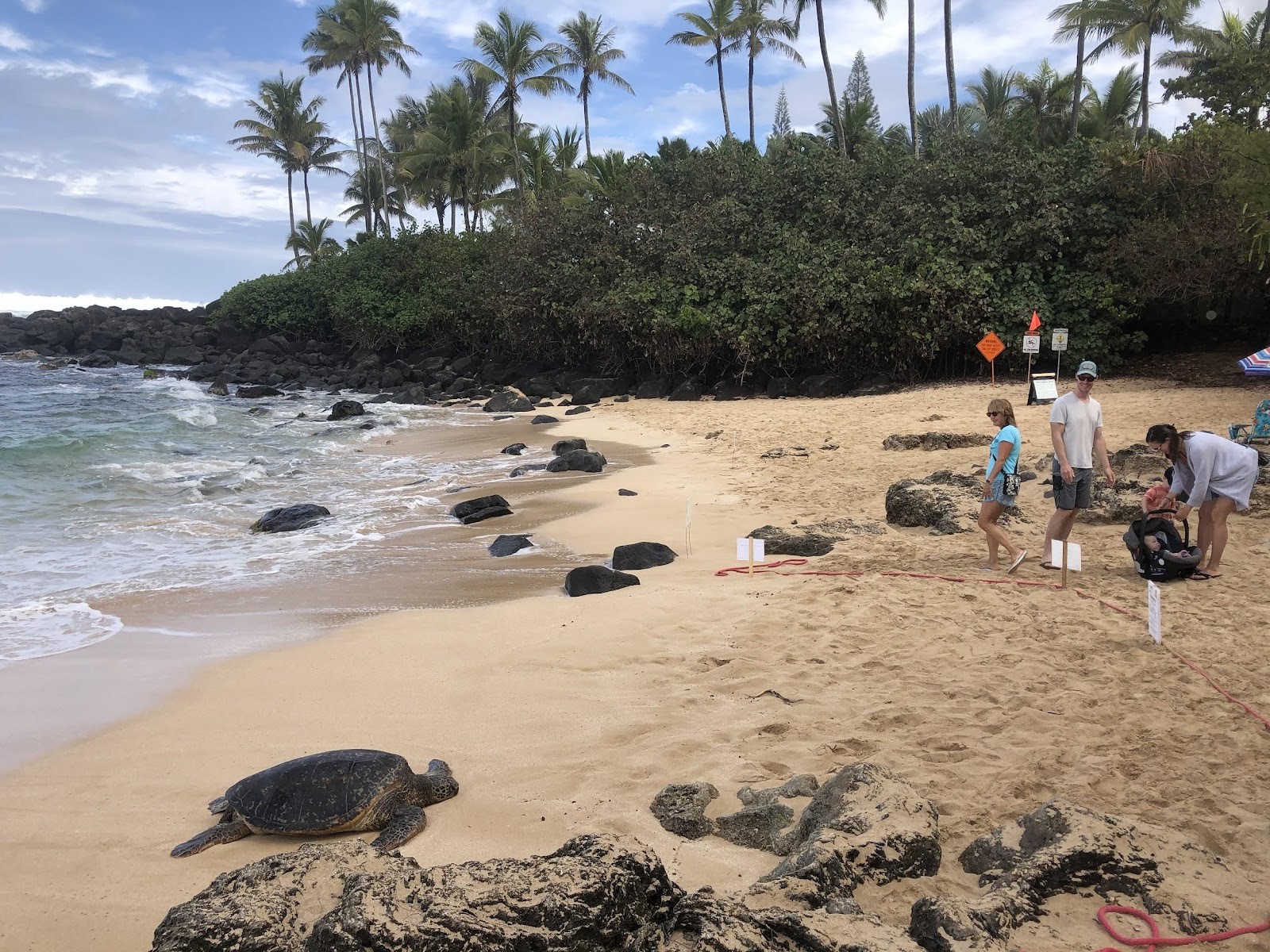
A honu basking at Laniākea Beach on O'ahu’s north shore, while members of the public stand a respectful distance away to observe the turtle without disturbing it. Credit: NOAA Fisheries/Camryn Allen.
Survey123 Instructions
To report your honu sightings, click here and it will direct you to our Honu Count Sighting
Survey.
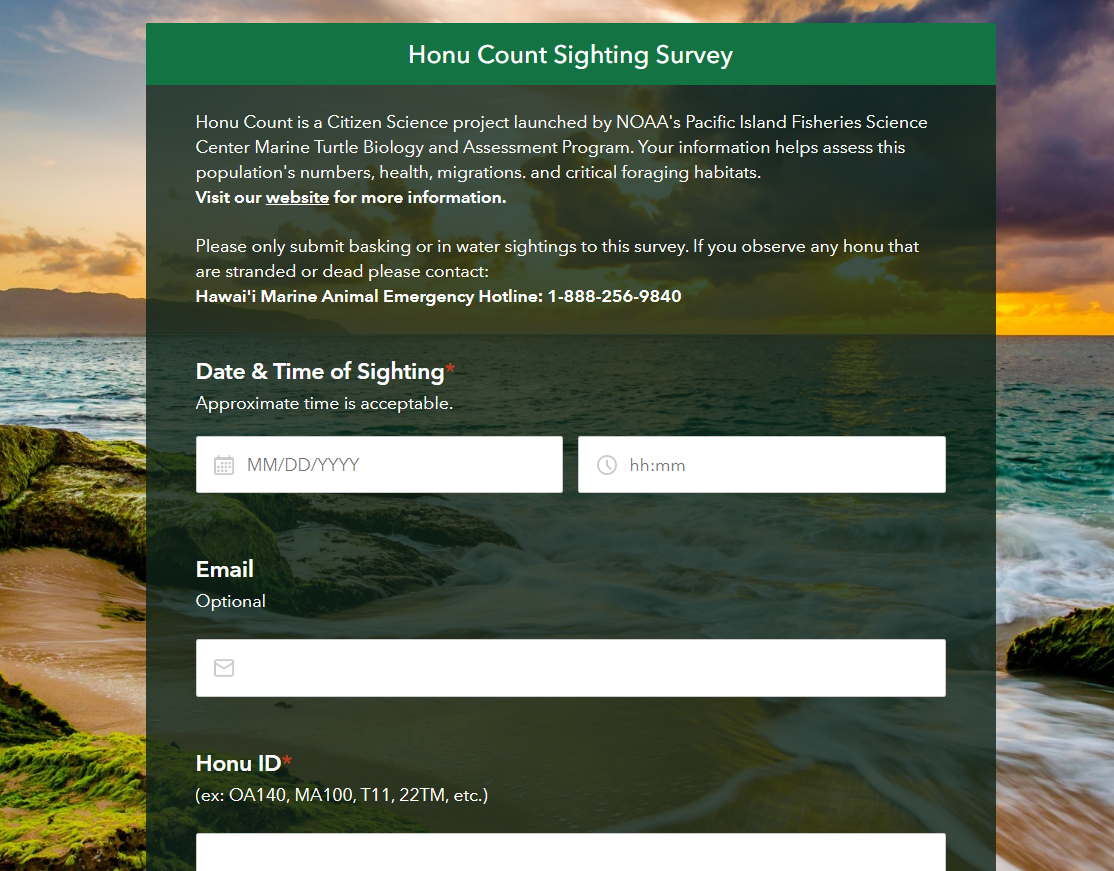
Tips
Survey123 is supported in Chrome, Microsoft Edge, Firefox and Safari. However, it works best when using Chrome. Note: Safari does not support Survey123 as well as other browsers.
The Honu Count Survey123 website can be accessed using your smartphone, computer or tablet.
Certain fields are required when submitting your survey, so please fill those fields out to the best of your ability.
In order to gather accurate location information, there is a map in the survey where you can zoom in or out to drop a pin of the location of your turtle sighting. This helps us determine foraging habitats for this population.
To report any emergencies (dead or injured animals) call NOAA’s Marine Wildlife Hotline: (888) 256-9840.
Decoding Shell Etches
You may be wondering, ‘what does the shell etch mean’? The letters refer to the location the turtle was encountered and where, or what island, the shell etch was applied. You can decode it using the table below, which shows the codes for each island (note: turtles were not given a shell etch on islands in the Hawaiian archipelago that are not listed). For turtles within Lalo/French Frigate Shoals only, males are designated with an additional letter ‘M’- look for a long and thick tail as this also signifies the turtle is a male.
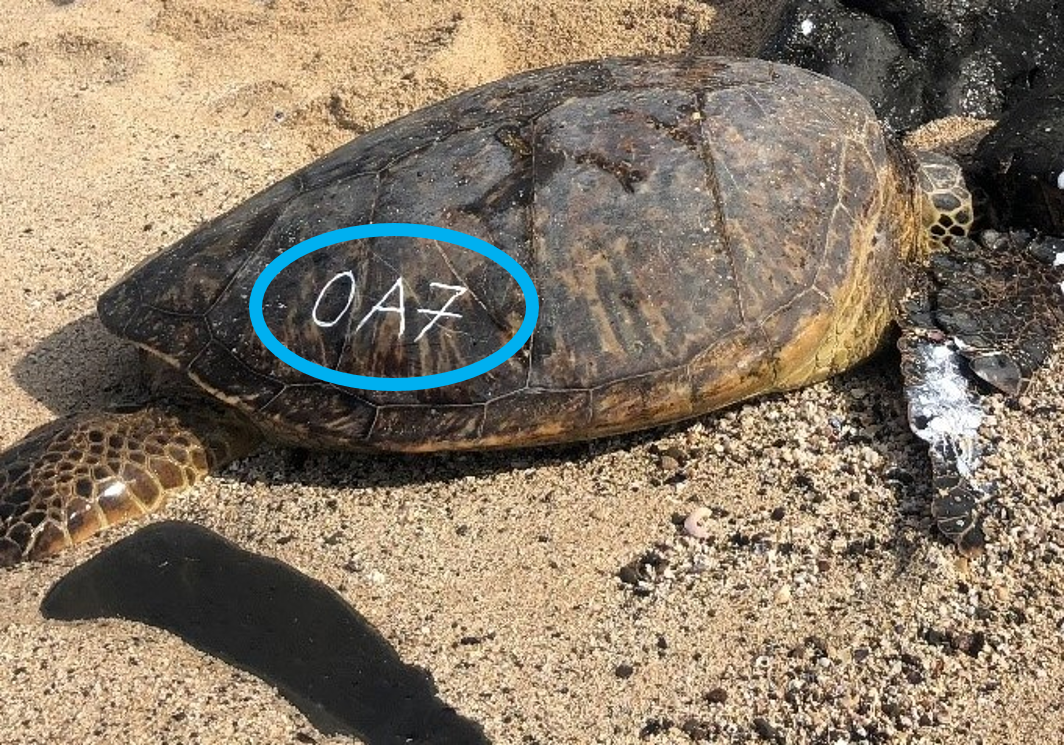
An example of an alpha-numerica identifier on a honu. The “OA'' part of the etching signifies that this turtle was originally sighted and tagged on O'ahu. Credit: NOAA Fisheries.
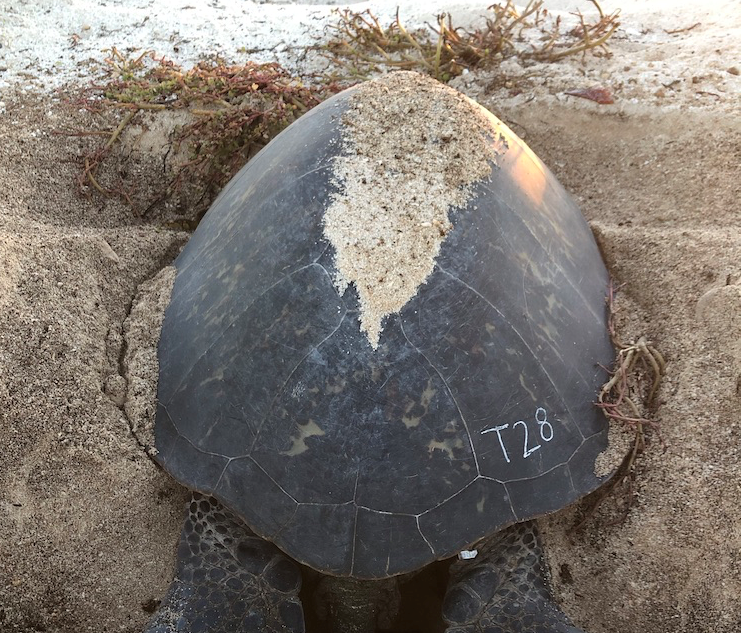
An example of an alpha-numerica identifier on a honu that was originally identified nesting on Tern Island, according to the “T” etching. We know she is a nesting female because all Lalo/French Frigate Shoals male honu are also marked with a “M”. Credit: NOAA Fisheries.
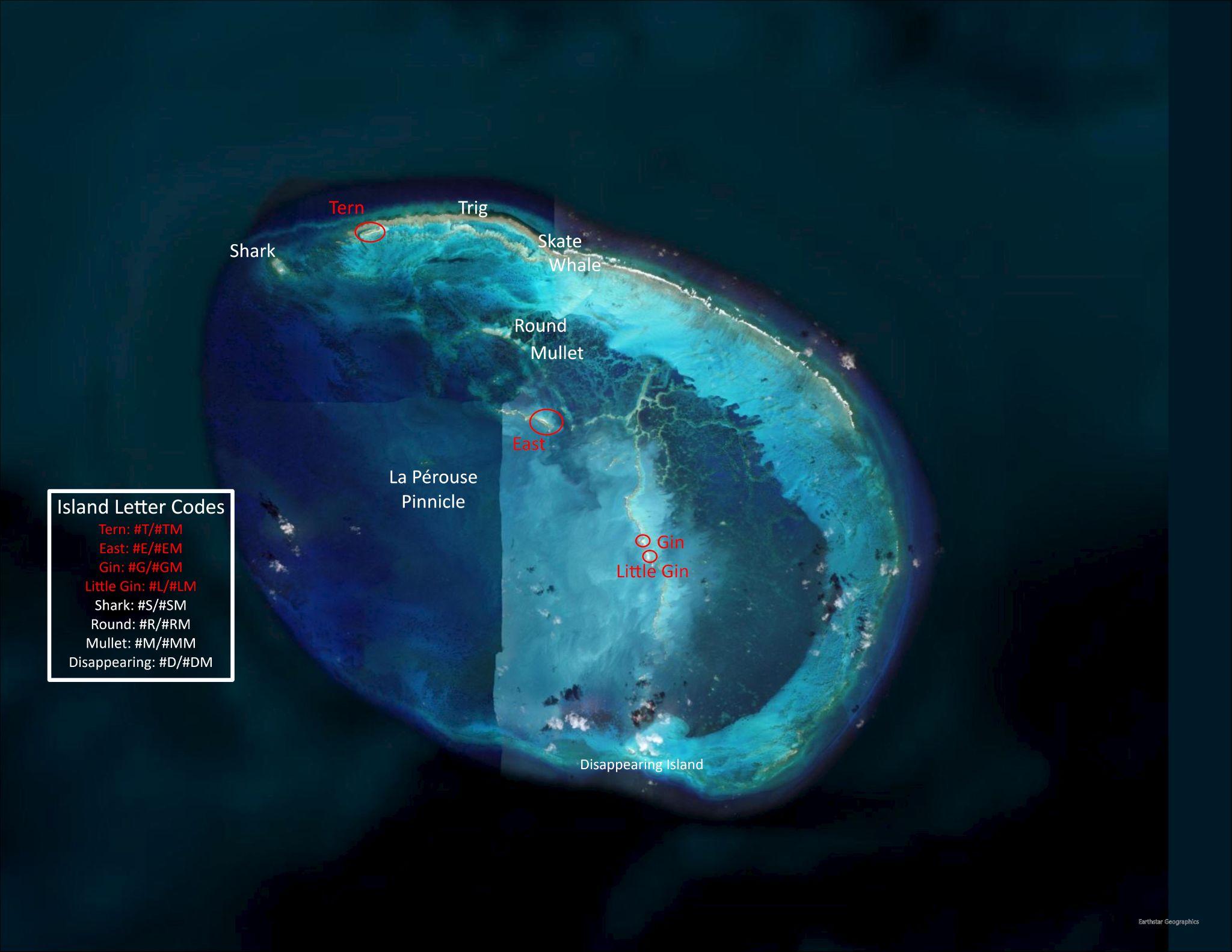
Lalo, also known as French Frigate Shoals, lies within the Papahānaumokuākea Marine National Monument. 96 percent of the Hawaiian green sea turtle population nests within this small atoll. Red font and circles indicate islets that are not submerged or are only partially submerged where honu could nest or bask (i.e. current viable nesting habitat). Historically, the main nesting island was East Island within the atoll, but it was washed out in 2018 due to Hurricane Walaka. Credit: Esri ArcGIS Pro/NOAA Fisheries.
Note: For Lalo and other PMNM sites the IDs for the turtles switch every year so either the lettering or the numbers come first. For example, in 2021 the first female sighted on Tern Island and given a temporary ID of “1T”, but in 2022 the first female sighted on Tern Island was given “T1”.
Island/Islet |
Shell Etch Lettering Code |
Hawai'i |
HA |
Maui |
MA or MG |
O'ahu |
OA |
Kaua'i |
KA |
Lalo (French Frigate Shoals) Atoll |
|
Tern |
T or TM |
East |
E or EM |
Trig |
C or CM |
Gin |
G or GM |
Little Gin |
L or LM |
Shark Round Mullet Disappearing |
S or SM R M D |
Kamole (Laysan) |
LY |
Kapou (Lisianski) |
LS |
Manawai (Pearl and Hermes Reef) |
PH |
Kuaihelani (Midway) |
MW |
Hōlanikū (Kure) |
KU |
Frequent Sightings
These turtles are sighted and reported frequently by members of the public, providing us with a lot of data already acquired on these particular turtles at these specific locations.
Honu ID |
History |
129 |
First tagged and sighted in 2016, this immature honu likes to spend time around Hawai'i Island Kailua-Kona area. |
HA20 |
Since 2019 HA20 is often seen around Big Island on and off Puako Beach. |
HA21 |
HA21 was initially tagged in 2017 on Puako Beach. The immature turtle bounces between Puako Beach and Waikōloa on Big Island. |
HA25 |
HA25 is an immature turtle first sighted in 2019 on Puako Beach. |
HA27 |
HA27 is an immature turtle first sighted in 2019 on Puako Beach. |
HA33 |
HA33 is an immature turtle first sighted in 2019 on Puako Beach. |
HA103 |
An immature green sea turtle first tagged and sighted in 2022. |
MA100 |
MA100 is commonly seen around Kāʻanapali since 2021. |
MA101 |
MA101 is commonly seen around Kīhei, but was first sighted at Māʻalaea Bay in 2021. |
MA108 |
First sighted in 2021 at Kāʻanapali, and can also be seen at Lāhainā. |
MA130 |
First sighted at Makena Landing Beach Park in 2021, and can be seen around Kīhei and at Keawakapu Beach. |
MA143 |
First sighted in 2021 in Kīhei and can still be seen around there. |
MA145 |
Sighted on Maui in 2021 at Kama'ole Beach Park. |
MA165 |
First sighted in 2021, MA165 can be seen basking on many beaches around Lāhainā. |
MA168 |
This Maui turtle was first sighted in 2021, and is most often seen at Kāʻanapali. |
MA190 |
Since 2021, MA190 is most often seen around Waialae-Makena on Maui. |
MA198 |
Over 2022, MA198 is usually seen around Kīhei. |
MA42 |
This 2021 Maui turtle is often sighted around Wailea-Makena on Maui. |
MA72 |
First sighted in 2021 at Nāpili-Honokōwai, MA72 can still be seen in and around the waters of Lāhainā. |
Field Research
MHI
At the PIFSC in Honolulu, the MTBAP team collaborates with partners on all eight main Hawaiian Islands to gather data and provide care for injured turtles that live and forage around Hawai'i. Generally, only adult female sea turtles come ashore (to lay eggs), however, Hawai'i is one of three places in the world where sea turtles (all sizes and sexes) haul out on land to ‘bask’. They can be seen doing this for hours at a time, sometimes overnight. Basking behavior provides researchers with a golden opportunity to observe these animals up close and collect data that would otherwise be very difficult to collect in water. While the turtles bask on the beach, MTBAP and partners conduct surveys counting turtles, applying semi-permanent metal tags and semi-permanent microchips - very much like the ones the veterinarians give dogs or cats. This is also when temporary alpha-numeric IDs are applied to their shells, making it possible for researchers and the public to easily identify individual turtles, as well as making Honu Count possible! This gives us a good insight into the population numbers, overall health of the individual turtles that are sighted, as well as, where foraging habitats are used the most.

Reported public sightings of green sea turtles within the main Hawaiian Islands. The red symbols show turtles sighted only within the main Hawaiian Islands, and the yellow symbols show turtles that are reproductive adults originally tagged at Lalo and sighted returning to their foraging grounds. This gives us valuable information on where the population of honu (Hawaiian green sea turtles) are foraging and living, as well as where they return to after they reproduce. Credit: NOAA Fisheries.
Temporary satellite tags are also attached to the shells of fertile adult female turtles. Starting in February, MTBAP - along with partners - search the database to identify and visually look for basking adult honu who might be nesting at Lalo that year. Taking advantage of their basking behavior, MTBAP performs ultrasounds on adult females looking for yolk in their egg follicles, which indicates the female is fertile and likely to migrate to Lalo to nest. Special emphasis is put on female turtles that have been previously tagged with a permanent tag and have previously nested on East Island, such as Motherload. Motherload was given a satellite tag in 2020 and her migration was tracked all the way to her nesting grounds on Tern Island within Lalo. More on Motherload’s journey here.
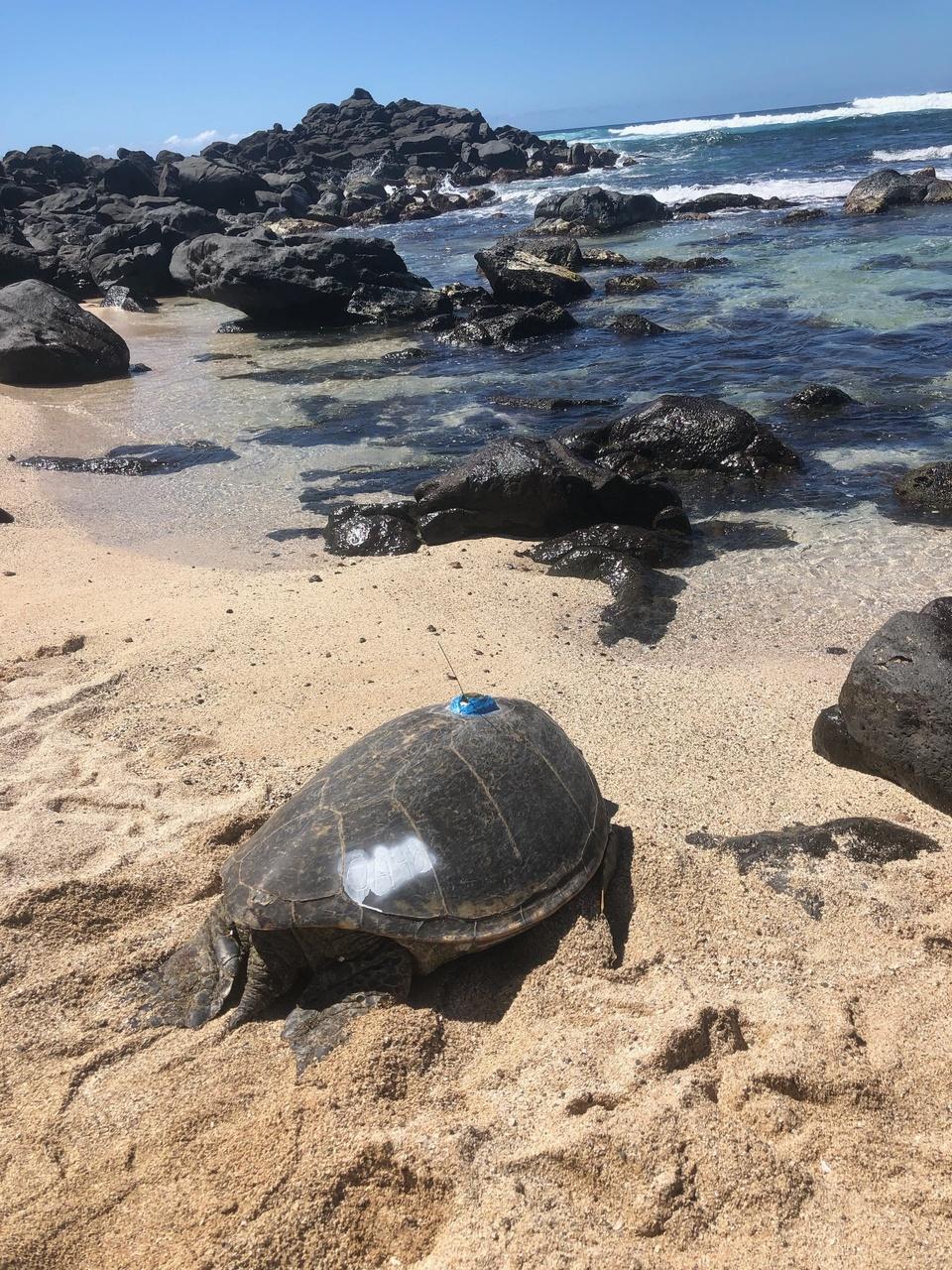
Fertile sea turtle OA48, nicknamed Motherload, returns to the ocean after biologists attached a satellite tag to her shell to track her migration to her nesting beach in 2020. Credit: NOAA Fisheries.
Another aspect of MHI research is the stranding response by MTBAP and partners. When a turtle strands,they are either sick or injured and unable to make it out back to sea, or they are found dead on the beach. Veterinarians assess sick or injured turtles and diagnose the issues and give the best possible treatment they can to make sure the turtles can be released back to their homes in the sea. After treatment, the turtles are given semi-permanent tags as well as the temporary shell etchings so we can track their health. When dead turtles wash up on the beaches, we use them to gather more information on this species by performing necropsies. For juvenile turtles, it is not possible to tell their sex externally by looking at them, though when we perform necropsies we are able to identify the sex of the juvenile turtles by visualizing their internal gonads. However, if you see a large sea turtle with a very long and thick tail it's an adult male, and adult females are just as large but with thinner short tails. This information goes towards research that focuses on reproductive status and sex ratios of honu. Causes of strandings and death are also very important data points we gather to determine what is the biggest threat to the population.
If you see a stranded turtle, please call NOAA’s stranding response hotline at: (888) 256-9840.
NOAA’s stranding response partners within the main Hawaiian Islands will respond to stranded sea life.
Hawai'i Island:
Kaua'i/Moloka'i/ Lāna'i: DLNR
We intend to provide a bi-annual data update each year by December 30. However, data on this site are provided by the Marine Turtle Biology and Assessment Program, are preliminary in nature, and are subject to change without notice. For these reasons, we advise that users consider these data for illustrative purposes only. If you wish to pursue scientific inquiries using the data on this site, please contact PIFSC to ensure that the data meet your intended needs.
Data Disclaimer: PIFSC has taken great strides to ensure the data provided on this site meets the highest data quality and assurance standards.
PMNM
Each year, NOAA Fisheries biologists live for several months on the islands within the PMNM to study Hawaiian green sea turtles and Hawaiian monk seals.
Field research camps with teams of 3 to 7 biologists are generally established at the following five sites:
Lalo (French Frigate Shoals Atoll)
Kamole (Laysan Island)
Kapou (Lisianski Island)
Manawai (Pearl and Hermes Reef)
Hōlanikū (Kure Atoll)
While members of the US Fish and Wildlife Service live permanently on Kuaihelani (Midway Island) and assist with sea turtle research and monitoring in collaboration with NOAA Fisheries.
Since 1973, NOAA Fisheries biologists have been monitoring honu nesting activity during their summer field survey in the PMNM. Field researchers rotate between working day and night, counting every nesting and basking turtle they encounter. Field researchers within the PMNM and main Hawaiian Islands carefully etch temporary alpha-numeric identifiers on the turtles’ shells using a dremel tool (same tool used when getting an acrylic manicure) to allow for ease of identification from afar. Just like our fingernails, sea turtle carapaces (shells) are made out of keratin, causing the numbers that are applied to be temporary, lasting for about a year.
After reproducing in the PMNM, these voyagers return to nearshore foraging grounds in the main Hawaiian Islands to feed and bask and can be seen in greater numbers by August. By tracking these turtles, we can better understand important honu habitats and distribution throughout the main Hawaiian Islands. Additionally, any turtle that has been treated and released by NOAA’s stranding program also receives a shell etch in order to monitor their recovery. Therefore, reporting numbered turtles contributes to both science and conservation!

An example of a fertile green sea turtle, known as Motherload, migration in 2019 from foraging grounds in the main Hawaiian Islands to her nesting grounds in Lalo. Motherload was tagged with a satellite tag as well as a temporary alpha-numeric number “OA48” that was visible on her shell so she could be easily identified by the public and researchers. More on Motherload’s journey here Credit: NOAA Fisheries.
Contact Information
If you encounter any problems with the tools presented on this page, have ideas for new tools, would like to learn more about these data, or are interested in research at the Pacific Islands Fisheries Science Center, please contact: [email protected]
NOAA Inouye Regional Center (IRC)
Attn: NMFS/PIFSC
1845 Wasp Boulevard, Building 176
Honolulu, HI 96818
Phone: (808) 725-5360
Fax: (808) 725-5475

| File Type | application/vnd.openxmlformats-officedocument.wordprocessingml.document |
| Author | Joe.I.Terry |
| File Modified | 0000-00-00 |
| File Created | 2023-10-08 |
© 2026 OMB.report | Privacy Policy